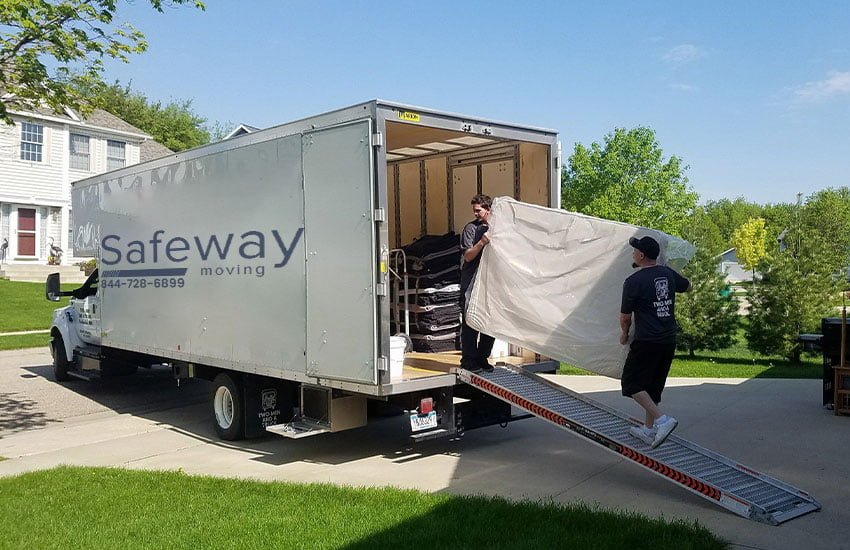At opposite ends of the moving spectrum are moving everything using your family and friends for labor, borrowed vehicles, and scrounged boxes. The other end of the spectrum is to hire a premium moving company to do everything from organizing to packing, transporting, and unpacking to settle in. As you might expect, the latter option is the most expensive. The pros and cons of each relocation type are discussed below.
DIY Moving
When you do the entire move yourself, you will need to be aware of the physical challenges as well as the mental and emotional stresses. If you are young and strong or have a group of family and friends willing to help, the cost of your relocation can be relatively low. You can find low or no-cost boxes and load your possessions into the containers. Pay for a pizza or two and perhaps a keg to share with your moving crew, and you can get the job done. This approach usually works better if the move is within a close area and your possessions are not fragile or plentiful.
Cost-Effective Long Distance Moving
A full-pack move is at the other end of the moving cost spectrum. In this iteration, the long-distance movers do everything related to the task. This level of moving costs is typically the highest. There are the costs of the packers, movers, transporters, sometimes temporary storage, and unpacking. There may be special handling on some items. With the understanding that the overall costs of the move may vary according to some costs being reduced through planning and tactics. Here are some ways that a long-distance move can cost less than a full-service relocation without reducing and quality of the experience.
Schedule Your Move Intelligently
Movers adjust their prices based on the outside temperature. Movers are less busy between October and April, so prices are lower. Conversely, if you have the flexibility to schedule your move between September and May, you will not only be able to save money, but your choice of available movers and dates is likely greater. The more flexible you are regarding special requirements and possible moving dates, the less money you will spend on the relocation. Other times to avoid scheduling a move are national holidays and the last weekends of a month. These dates can result in higher moving costs.
Do your due diligence as early in the process as possible. Get detailed quotes in writing from three or more long distance movers before making the final decision.
Reduce Your Possessions
A common mistake made by moving customers is choosing to take too many possessions when they move long distances. When organizing the belongings to prepare them for moving, customers will likely identify many items that won’t be useful in the new residence. They might not fit physically or be a good fit for climatic reasons. If you are paying to move items that you are unlikely to use in your new location, it is also inconvenient and costly. When preparing the items in your residence for transport, you should take the time to assess the sentimental, financial, and practical value of each of your belongings. Take only the things that are needed and loved to your new location. The fewer items that are transported, the lower the cost will be. When preparing and implementing your move, it is recommended that you declutter your home and pack only the items of the greatest sentimental, aesthetic, and practical value for the move. By choosing to downsize and eliminate clutter, you will save on packing materials, packing time, and the lowered cost of shipping your belongings.
Pack Your Items Yourself
By doing your packing, you will be able to cut the cost of the move significantly. An added advantage of self-packing is organizing your possessions to make unpacking and settling in much more efficient when you reach your destination. Labor costs are always a significant part of any move, so if you invest the time to take on this role yourself, you can replace the cost of professional labor with the investment of your own time. The packing is a physical challenge for most people and may require an hour or two each day in the weeks leading up to moving day.
Save On Packing Materials
Be sure to use adequate protection for your vulnerable or essential items. Use quality packing supplies and safe packing techniques. The most appropriate packing methods for each type of item require planning. Avoid common packing errors that damage your articles, waste time, and lose money. You can find
Inexpensive Packing Supplies
In advance of your move, calculate the amount and type of packing materials that will be needed, and acquire the packing supplies as inexpensively as possible. Look for ongoing promotions, discounts, and sales. Look for coupons to acquire the items at lower prices. You will need sealable bags, stretch wrap, bubble wrap, packing paper, and packing tape. These items will be required and purchasing in bulk is typically cheaper.
Look for ways to stock up on free supplies while preparing for your move. Examples are large, sturdy shipping boxes that arrive in the mail, packing peanuts, and air pouches. Friends, neighbors, or others may have suitable containers at little or no cost. Also, check for free offers on websites such as Craigslist.
Think about the use of alternative packing materials. These include suitcases, backpacks, baskets, and bags rather than purchasing packing boxes. To save money, you can replace packing paper and bubble wrap with newsprint, towels, old clothes, and other items.
Automobile Costs
Consider driving to your new site depending on the distance to your new location. You can take some items in your vehicle, which will save on the cost of shipping. It can also be a way to have an enjoyable trip. You can do some tourist activities to make a vacation for you and your family. Traveling in this way is typically less costly than paying for shipping an automobile and flying to your new destination. Look for information about attractions along the way and break up long stretches with fun stops.
Insurance
Protect your precious possession with careful packing, but also be aware that accidents happen. Insuring your fragile items is an excellent way to avoid financial losses due to damage to the things you move.
Planning
Any project as complex as a long-distance move requires planning. There are numerous resources available online to help with planning. Your local library may also provide information about moving. In addition, the regulatory sites for long distance movers should be accessed to be sure you are working with professionals.

